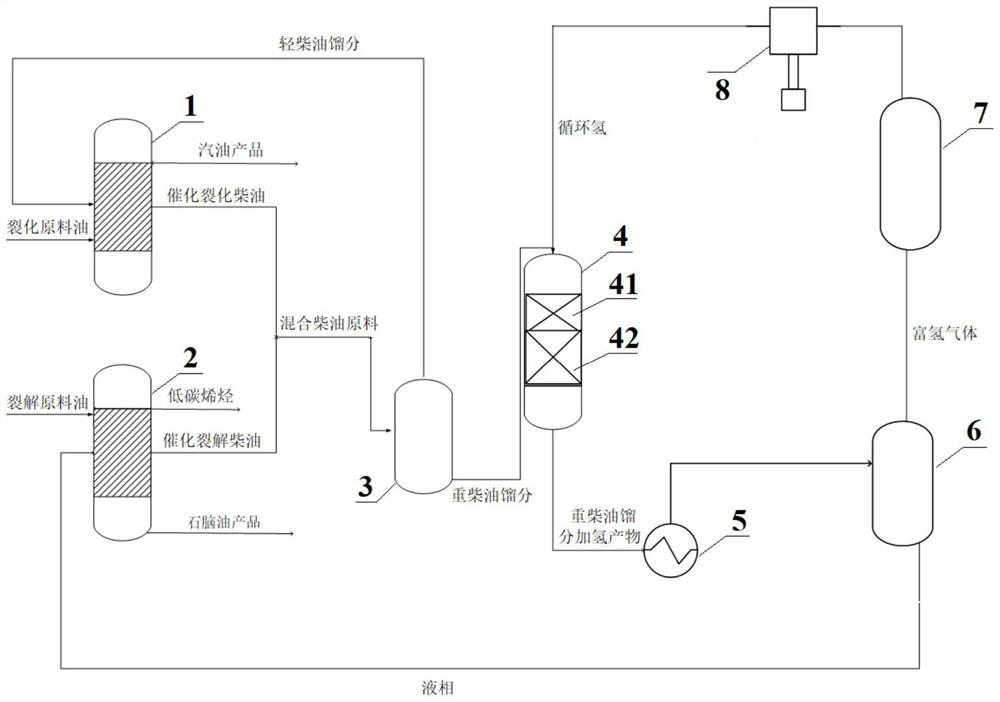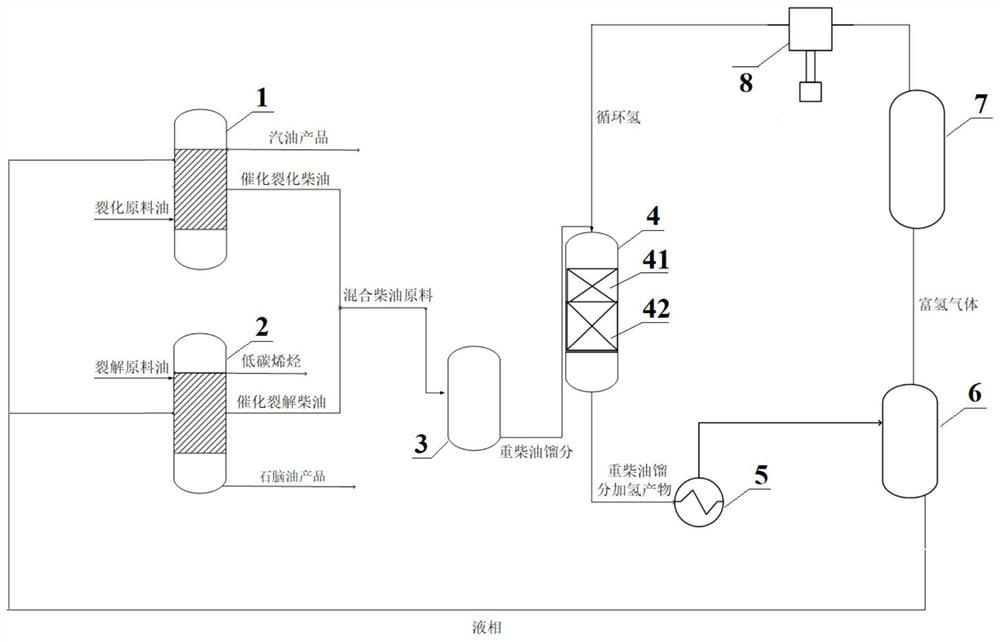Method for combined treatment of catalytically cracked diesel and catalytically cracked diesel and system
A catalytic cracking diesel, catalytic cracking technology, applied in the field of diesel processing, can solve the problems of high hydrogen consumption, high cost, low yield of olefins and aromatics, etc., to improve the hydrogenation activity of aromatics, reduce hydrogen consumption, and extend the operation cycle Effect
- Summary
- Abstract
- Description
- Claims
- Application Information
AI Technical Summary
Problems solved by technology
Method used
Image
Examples
Embodiment approach
[0074] The inventors of the present invention found in research that introducing a carboxylic acid compound into the second hydrogenation catalyst can protect the active components of the second hydrogenation catalyst and improve the activity of the catalyst. Therefore, as long as the carboxylic acid is introduced into the second hydrogenation catalyst, the effect of protecting the active components of the second hydrogenation catalyst and improving the activity of the second hydrogenation catalyst can be achieved, and there is no special limitation on the added amount. According to a preferred embodiment of the present invention, the dry basis weight ratio of the carboxylic acid to the inorganic refractory component is 0.1-0.8:1, preferably 0.2-0.6:1.
[0075]Preferably, the carboxylic acid is selected from C1-18 monobasic saturated carboxylic acids (for example, C1, C2, C3, C4, C5, C6, C7, C8, C9, C10, C11, C12, C13, C14, C15 , C16, C17, C18 monobasic saturated carboxylic ac...
preparation example 1
[0160] This preparation example is used to illustrate the source of the first hydrogenation catalyst
[0161] The first hydrogenation catalyst is the purchased molded RS-2100 catalyst, produced by Sinopec Changling Catalyst Branch. It is a nickel-tungsten catalyst with a bulk density of 1.03g / cm 3 , the average particle diameter is 2-3mm, and the specific surface area is 165m 2 / g.
preparation example 2-1
[0163] This preparation example is used to illustrate the second hydrogenation catalyst and its preparation method.
[0164] (1) commercially available white carbon black (specific surface area is 220m 2 / g, the average pore diameter is 12.7nm), mixed with basic cobalt carbonate powder, and then fired at 400°C for 3h to obtain cobalt-containing inorganic refractory powder.
[0165] Wherein, the amount of basic cobalt carbonate used corresponds to the content of cobalt (calculated as cobalt oxide) in the catalyst being 22.0% by weight.
[0166] (2) A certain amount of MoO 3 Add basic cobalt carbonate and citric acid into the aqueous solution containing phosphoric acid respectively, and dissolve them completely under heating and stirring to obtain an impregnating solution containing active metals.
[0167] Wherein, the mass of citric acid is 20% by weight of the mass of the inorganic refractory component.
[0168] (3) Mix the impregnating solution and the inorganic refractory...
PUM
| Property | Measurement | Unit |
|---|---|---|
| density | aaaaa | aaaaa |
| diameter | aaaaa | aaaaa |
| specific surface area | aaaaa | aaaaa |
Abstract
Description
Claims
Application Information
 Login to View More
Login to View More - R&D
- Intellectual Property
- Life Sciences
- Materials
- Tech Scout
- Unparalleled Data Quality
- Higher Quality Content
- 60% Fewer Hallucinations
Browse by: Latest US Patents, China's latest patents, Technical Efficacy Thesaurus, Application Domain, Technology Topic, Popular Technical Reports.
© 2025 PatSnap. All rights reserved.Legal|Privacy policy|Modern Slavery Act Transparency Statement|Sitemap|About US| Contact US: help@patsnap.com



